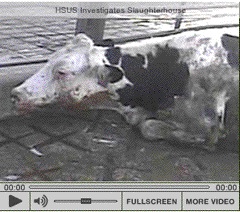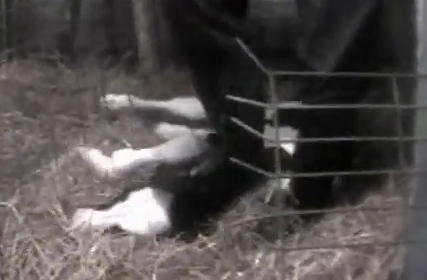It’s been almost 10 years since me and the ex-wife and the four kids got in the family van for our outsized family to drive to Atlanta for the annual  meeting of what is now know as the International Association for Food Protection (that’s Carl Custer, right, going to deliver his Ivan Parkin lecture a few years later and trying to convince Randy Phebus to buy a decent bike)..
meeting of what is now know as the International Association for Food Protection (that’s Carl Custer, right, going to deliver his Ivan Parkin lecture a few years later and trying to convince Randy Phebus to buy a decent bike)..
I was to give the Ivan Parkin lecture at the gala opening, and then would be supervising my kids as they grabbed as many freebies as possible when the trade show opened.
But we never made it.
We got to Detroit about 8 am on the Saturday morning after a 3-hour drive, and the kindly border guard said, sir, have you ever been arrested?
I sais yes, and said I have been in the U.S. about every other week for the previous three years, and she said , that’s nice, go on over there.
The dreaded secondary inspection.
I was subsequently informed after a couple of hours hanging out with my 5, 7, 10, 13-year-olds – and wife – that the U.S. had changed it’s border policy I would have to apply for a waiver to enter the U.S. and that would take six months.
But I’m supposed to talk in Atlanta tomorrow?
Six months.
The hungry family and I retreated to an IHOP in Windsor (that’s on the Canadian side of the U.S. border with Detroit), they ate syrupy stuff and I called IAFP leadership types in Atlanta.
We had been doing some consumer research at a farm market selling genetically engineered and conventional sweet corn and potatoes, and decided to start videotaping stuff, even though youtube.com didn’t exist and we weren’t sure what to do with the tapes. But we had bought a video recording device. So I suggested we tape the talk, e-mail it to Atlanta, and they could broadcast it.
There was no way I was getting across the border.
Because I like to be prepared, I hadn’t really done anything for this big-shot talk, so the ex-wife drove the three hours back to Guelph, I made up my talk, and Katija came over and taped me talking in my kitchen. That talk was broadcast as the Ivan Parkin lecture at the IAFP annual meeting the next night.
Now, it’s sorta routine. I’ve given at least 20 keynote speeches and presentations via programs such as Skype and iChat since 2000, using a combination of live video feeds and pre-recorded video, for crowds ranging in size from five to 800 people.
As reported in a campus publication this week,
According to Powell, there are many advantages to using this form of technology in delivering speeches, such as eliminating the costs and stresses of travel and increasing a professor’s overall availability. Although, it does come with additional challenges, he said, such as the ever-present possibility of disrupted Internet feed and a lack of feedback from the audience.
"I actually find it forces me to be more creative," he said. "If you’re giving a talk in person, you can tell when people are sort of zoning out or falling asleep and you can modify it. You don’t get that on video because you’re talking to a camera."
Powell said to help spice up the video feed he often integrates action segments into his pre-recorded speeches, for example, utilizing cooking as a form of demonstration.
Apparently Republican Minnesota governor Tim Pawlenty agrees with me, which is somewhat creepy. Pawlenty was on The Daily Show last week, and while poorly declining his presidential aspirations, said some decent stuff about education:
“For example, higher education. … Do you really think in 20 years someone’s going to put on their backpack, drive a half-hour to the University of Minnesota from the suburbs, haul their keester across campus, to sit and listen to some boring person drone on about Econ 101 or Spanish 101?
Is there another way to deliver the service other than a one-size fits all monopoly that says show up at 9 a.m on Wednesday. for Econ 101, Can’t I just pull that down on my iphone or ipad whenever the heck I feel like it and wherever I feel like it, and instead of paying thousands of dollars, can I pay $199 for iCollege instead of $0.99 for iTunes.
Pawlenty says this stuff about 5 minutes into the clip. Bricks and mortar just isn’t necessary for a lot of so-called education.
 facilities in North America.
facilities in North America.
 plants to enhance the company’s animal welfare protection systems. All of Cargill’s U.S. plants were expected to have the program in place by the end of 2009.
plants to enhance the company’s animal welfare protection systems. All of Cargill’s U.S. plants were expected to have the program in place by the end of 2009. slaughter when animals are not stunned. "The likelihood of a stunned animal being conscious is extremely small," said its veterinary officer Stephen Lomax. "This is not an animal welfare issue."
slaughter when animals are not stunned. "The likelihood of a stunned animal being conscious is extremely small," said its veterinary officer Stephen Lomax. "This is not an animal welfare issue." operations by using in-plant video monitoring.
operations by using in-plant video monitoring. Meat Packing Co. of Chino, Calif., tormenting cows that were too injured or weak to stand.
Meat Packing Co. of Chino, Calif., tormenting cows that were too injured or weak to stand. Animal Aid in the last year had highlighted abuses in U.K. slaughterhouses. The proposal is due to go before agency chiefs next week for approval.
Animal Aid in the last year had highlighted abuses in U.K. slaughterhouses. The proposal is due to go before agency chiefs next week for approval..jpg) For several years, the health department has sought to change that by posting details of restaurant inspections online. But budget cuts, combined with opposition from restaurant owners, have made that an elusive goal, said Stuart White, supervisor of community health in the environmental health division.
For several years, the health department has sought to change that by posting details of restaurant inspections online. But budget cuts, combined with opposition from restaurant owners, have made that an elusive goal, said Stuart White, supervisor of community health in the environmental health division. There was blue string soup in that Bridget Jones movie.
There was blue string soup in that Bridget Jones movie. The name of the discount chain that sold the cheese was not disclosed, because it had "managed the situation well" and immediately removed the cheese in question from its shelves, a police statement said.
The name of the discount chain that sold the cheese was not disclosed, because it had "managed the situation well" and immediately removed the cheese in question from its shelves, a police statement said. meeting of what is now know as the International Association for Food Protection (that’s Carl Custer, right, going to deliver his Ivan Parkin lecture a few years later and trying to convince Randy Phebus to buy a decent bike)..
meeting of what is now know as the International Association for Food Protection (that’s Carl Custer, right, going to deliver his Ivan Parkin lecture a few years later and trying to convince Randy Phebus to buy a decent bike).. of cruelty to animals after a welfare group released a video it says shows him and others beating cows with crowbars and pitchforks.
of cruelty to animals after a welfare group released a video it says shows him and others beating cows with crowbars and pitchforks. Or at least try something new – the stuff that is out there just doesn’t work.
Or at least try something new – the stuff that is out there just doesn’t work. * While a bar graph showing the temperature distribution of the finished burgers demonstrated that many were at or near the recommended 160 degrees F, a few of the burgers’ temperatures were recorded to be much lower — as low as 112 degrees F. (Study coordinators observing consumer behavior made sure all burgers were cooked to 160 F before volunteers consumed them.)
* While a bar graph showing the temperature distribution of the finished burgers demonstrated that many were at or near the recommended 160 degrees F, a few of the burgers’ temperatures were recorded to be much lower — as low as 112 degrees F. (Study coordinators observing consumer behavior made sure all burgers were cooked to 160 F before volunteers consumed them.).jpg) Beef industry representatives here said they could adapt to the new standards but pressed the USDA to move fast so they know what changes will be required.
Beef industry representatives here said they could adapt to the new standards but pressed the USDA to move fast so they know what changes will be required.